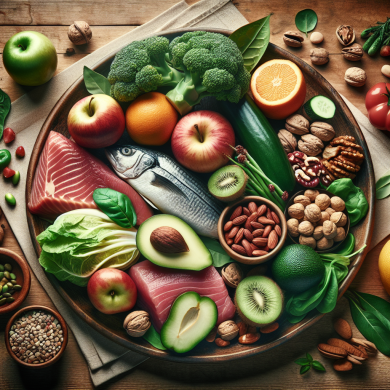Paleo Diet: Unlocking Natural Nutritional Benefits
Introduction to the Paleo Diet
The Paleo Diet, often referred to as the “Caveman Diet,” is a nutritional plan that aims to mimic the dietary habits of our Paleolithic ancestors. The core principle of this diet is to consume foods that were available before the advent of agriculture, approximately 10,000 years ago. This means a focus on whole foods such as meats, fish, vegetables, fruits, nuts, and seeds, while avoiding processed foods, grains, legumes, and dairy products.
The Philosophy Behind the Paleo Diet
The Paleo Diet is based on the belief that modern human beings are genetically adapted to the diet of their ancestors and that the agricultural revolution introduced dietary changes that our bodies have not fully adapted to. Proponents of the Paleo Diet argue that by eating like our ancestors, we can improve our health, reduce the risk of chronic diseases, and maintain a healthy weight.
The Genetic Argument
One of the key arguments for the Paleo Diet is that our genes have changed very little since the Paleolithic era. The human genome has evolved over millions of years, and our bodies are still optimized for the diet of hunter-gatherers. The introduction of grains, legumes, and processed foods is seen as a mismatch between our biology and our environment, leading to various health issues.
Impact of the Agricultural Revolution
The agricultural revolution brought about a significant shift in human diets. The reliance on grains and the domestication of animals for dairy products introduced new food sources that were not part of the Paleolithic diet. Many believe that this shift has contributed to the rise in lifestyle-related diseases such as obesity, diabetes, and heart disease.
Nutritional Components of the Paleo Diet
The Paleo Diet emphasizes unprocessed, nutrient-dense foods that provide a broad spectrum of essential nutrients. Here are the primary components of the Paleo Diet:
Lean Proteins
Lean meats, fish, and seafood are central to the Paleo Diet, providing essential amino acids, vitamins, and minerals. These proteins support muscle growth, repair, and overall cellular function. Grass-fed meats and wild-caught fish are preferred due to their higher omega-3 fatty acid content.
Fruits and Vegetables
Fruits and vegetables are consumed in abundance on the Paleo Diet, offering a rich source of vitamins, minerals, and antioxidants. These foods support immune function, reduce inflammation, and contribute to overall health. The focus is on non-starchy vegetables and low-glycemic fruits to maintain stable blood sugar levels.
Healthy Fats
The diet includes healthy fats from sources like avocados, nuts, seeds, and olive oil. These fats are crucial for hormone production, brain function, and maintaining healthy skin. The emphasis is on monounsaturated and polyunsaturated fats while avoiding trans fats and excessive saturated fats.
Nuts and Seeds
Nuts and seeds provide a good source of healthy fats, fiber, and protein. They also contain essential vitamins and minerals like magnesium, zinc, and vitamin E. However, portion control is important due to their high-calorie content.
Benefits of the Paleo Diet
Adopting a Paleo Diet can offer numerous health benefits, many of which are supported by scientific research.
Weight Loss and Management
By eliminating processed foods and focusing on nutrient-dense options, the Paleo Diet can help individuals achieve and maintain a healthy weight. The diet’s high protein content increases satiety, reducing overall calorie intake.
Improved Blood Sugar Control
The exclusion of refined sugars and grains can lead to better blood sugar regulation. This makes the Paleo Diet a potential option for those with insulin resistance or type 2 diabetes, as it may help stabilize blood sugar levels.
Reduced Inflammation
The Paleo Diet is rich in anti-inflammatory foods such as fruits, vegetables, fish, and nuts. By reducing the consumption of inflammatory foods like processed grains and sugars, individuals may experience decreased inflammation and related symptoms.
Enhanced Digestive Health
The diet’s emphasis on whole foods and fiber-rich fruits and vegetables supports a healthy digestive system. It may alleviate digestive issues such as bloating, constipation, and irritable bowel syndrome (IBS).
Challenges and Considerations
While the Paleo Diet offers numerous benefits, it is important to consider potential challenges and ensure a balanced approach.
Nutrient Deficiencies
The exclusion of entire food groups, such as dairy and legumes, can lead to nutrient deficiencies if not carefully managed. It is important to ensure adequate intake of calcium, vitamin D, and other essential nutrients through alternative sources.
Social and Practical Considerations
Adhering to the Paleo Diet may require significant lifestyle changes and can be challenging in social settings. Meal preparation may also require more time and effort due to the focus on whole foods.
Environmental Impact
The emphasis on meat consumption raises concerns about the environmental impact of increased livestock production. Sustainable and ethical sourcing of meat and fish is crucial to minimize the diet’s ecological footprint.
Conclusion
The Paleo Diet offers a return to the dietary practices of our ancestors, emphasizing whole, unprocessed foods that align with human evolutionary biology. While it provides numerous health benefits, it is essential to approach the diet with a balanced and informed perspective, considering potential challenges and individual nutritional needs. By doing so, individuals can unlock the natural nutritional benefits of the Paleo Diet and support a healthier, more sustainable lifestyle.















Add comment